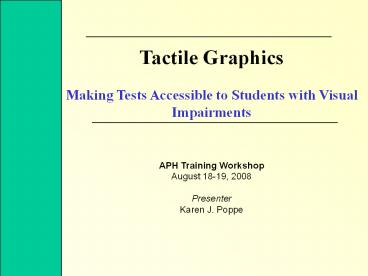Tactile Graphics - PowerPoint PPT Presentation
1 / 49
Title:
Tactile Graphics
Description:
Objects/pictures can be identified despite different rendering styles (e.g. ... Arizona's Instrument to Measure Standards (AIMS): Sample Tests ... – PowerPoint PPT presentation
Number of Views:113
Avg rating:3.0/5.0
Title: Tactile Graphics
1
Tactile Graphics Making Tests Accessible to
Students with Visual Impairments APH Training
Workshop August 18-19, 2008 Presenter Karen J.
Poppe
2
- Tactile Graphics are used by braille readers to
obtain information that print readers get from
visual pictures. - TACTILE can be perceived by touch
- Other terms used
- Raised-line graphics, pictures, or illustrations
- Embossed images
- Relief drawings
- Tactile representations/displays
3
- When is a Tactile Graphic Necessary?
- To convey the structure of objects too difficult
to understand through words alone - To describe a real object that cannot be
experienced through touchi.e., its too large or
too small to examine - When the shape/form/pattern is important to
demonstrate - To illustrate scale relationships biology,
maps, mathematics - When a map/figure/graph is needed by a student to
participate in classroom discussions or to answer
questions
4
- When is a Tactile Graphic Necessary?
- To orient tactile readers to objects/places in
everyday life (e.g., map of a campus, bus route,
airport terminal, etc.) - To enhance educational experiences (e.g., to add
interest to braille storybooks)
5
VISUAL vs. TACTUAL PERCEPTION Visual
Perception--Objects can be experienced in their
totalityat a glance --Depth, foreshortening,
slight shading and size differences, etc., can be
discerned. --Objects/pictures can be identified
despite different rendering styles (e.g.,
outline, cartoon, photograph, certain viewpoint,
etc.) Tactual Perception --Based upon sequential
observation --Individual pieces of information
are connected to build a mental image. --Depth is
lost --Subtle dimensional changes cannot be
detected, nor subtle line directions or textural
differences.
6
- Hands-on Tactile Activities
7
- Successful interpretation of tactile graphics
will depend upon - A students tactile skills and past experiences
with tactile graphics refer to handout in folder
on Early Tactile Skills and Concepts - Quality of the tactile graphics created (e.g.,
adherence to TG standards and appropriate
selection of tactile method)
8
COLORS FROM DIFFERENT PALETTES
Capsule Paper
Thermoform
Embossed Paper
Thermography
Braille Graphics
Collage
refer to handout in folder on Tactile Graphic
Methods
9
TACTILE TERMINOLOGY Basic Ingredients of a
Tactile Graphic
- Lines
- Point Symbols
- Areal/textured patterns
- Labels
labels
refer to handout in folder on Tactile
Terminology
10
TACTILE DESIGN PRINCIPLES/CONVENTIONS
- Simplify
- Eliminate unnecessary information and decorative
frills, i.e., tactile clutter - Important
- During test adaptation, its understood that
some distractors are intentional and should be
incorporated into the graphic. The desired goals
are to 1) maintain the original intent of the
test item 2) prevent giving unfair advantage to
the braille reader 3) ensure tactile
readability.
11
TACTILE DESIGN PRINCIPLES/CONVENTIONS
- Simplify (cont.)
- Replace complex objects with simple shapes
(e.g., point symbols for counting tasks) - Complex diagrams may be separated into two
separate tactile displays. - Replace 3D figures with 2D, except for some
mathematical and scientific diagrams.
12
TACTILE DESIGN PRINCIPLES/CONVENTIONS
- Resize Graphic
- Enlarge graphic for braille label placement and
sufficient space between tactile elements. - Enlarge graphic to show critical details or to
increase clarity. - Distort space or shape if necessary.
13
TACTILE DESIGN PRINCIPLES/CONVENTIONS
- Consistency
- Same tactile design styles are employed from one
graphic to the next. For example selected
texture to symbolize water should be applied to
all maps. - Keys/legends are always placed directly before
the graphic, either on the same page or previous
page - Facing pages are used when test item requires
more than one page.
14
TACTILE DESIGN PRINCIPLES/CONVENTIONS
- Consistency
- Compass rose and mileage scale are always moved
to the top of the page. - Grid lines in a graph should be less significant
than plotted data axis lines should be heavier
than grid lines. - Order of key listing 1) textures 2) lines 3)
point symbols 4) alphabetic key 5) numeric key
15
RESEARCH ENDEAVORS BANAS GRASP STUDYGraphics
Research And Standards Project APH Research
Product Development
16
Tactile Tools and Materials Useful to Braille
Readers for Test Taking Purposes
17
- The sample test items shown in following slides
were obtained from - Arizonas Instrument to Measure Standards
(AIMS) Sample Tests - http//www.ade/az.gov/standards/AIMS/
SampleTests/ - Florida Comprehensive Assessment Test Sample
Test Material Archive - http//www.firn.edu/doe/sas/fcat/ facatsmpl.htm
18
Rating Scale
GOOD Minimal or no adjustments needed, OR
graphic not necessary at all BAD Requires some
adjustments that would make it tactually
understandable UGLY Extensive adjustments
needed, OR not feasible for tactile readability
purposes.
19
G
AIMS Grade 5
20
G
FCAT Grade 5
21
G
AIMS Grade 3
22
G
AIMS Grade 5
23
G
AIMS Grade 4
24
G
FCAT Grade 4
25
G
AIMS Grade 3
26
G
AIMS Grade 4
27
G
FCAT Grade 4
28
B
AIMS Grade 3
29
B
AIMS Grade 7
30
B
AIMS Grade 4
31
B
- Which kind of shoe is worn by the greatest number
of students? - Sneakers B. Sandals
- C. Boots D. Flip Flops
AIMS Grade 4
32
B
FCAT Grade 4
33
B
AIMS Grade 4
34
B
AIMS Grade 4
35
B
AIMS Grade 4
36
B
AIMS Grade 7
37
B
AIMS Grade 5
38
B
FCAT Grade 5
39
B
AIMS Grade 7
40
B
FCAT Grade 9
41
B/U
AIMS Grade 5
42
B/U
FCAT Grade 11
43
U
AIMS Grade 7
44
U
FCAT Grade 5
45
U
FCAT Grade 4
46
Tactile Graphics Worksheet Activity
47
Tactile Graphics Worksheet Activity
48
Tactile Graphics Quiz
49
PowerPoint created by Karen J. Poppe Tactile
Graphics Project Leader American Printing
House for the Blind































